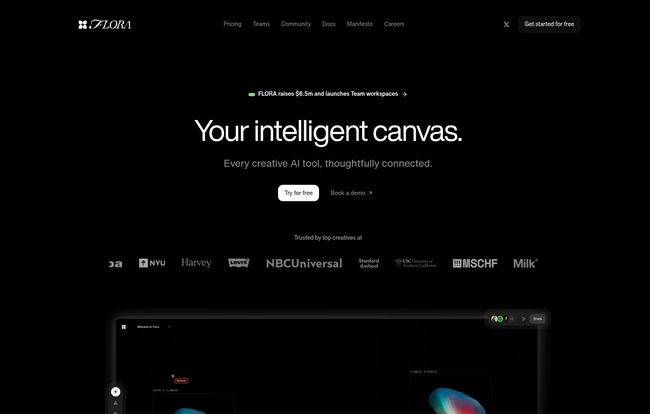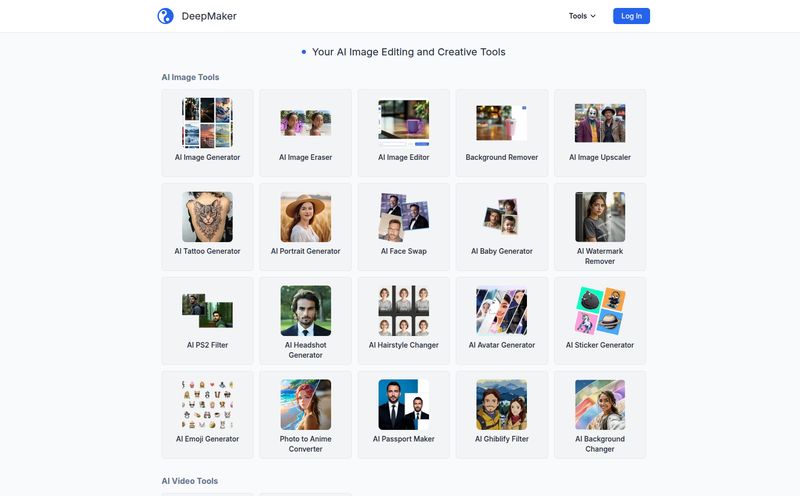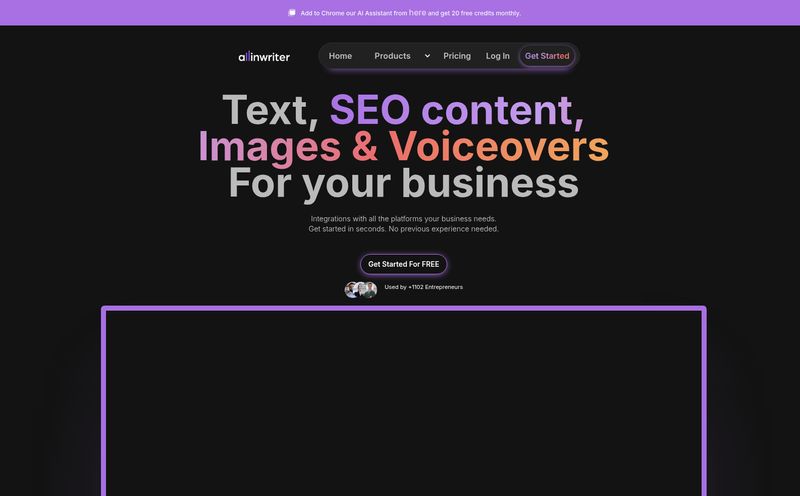If your browser looks anything like mine on a typical Tuesday, it’s a chaotic mess of tabs. I've got ChatGPT open for brainstorming ad copy, Midjourney running in a Discord window for hero images, maybe a separate AI video tool spinning its wheels on a social clip, and probably a background remover for good measure. It’s a workflow, I guess, but it feels more like digital whack-a-mole. Each tool is great in its own little silo, but getting them to talk to each other? A total headache.
I’ve been in the SEO and content game for years, and I’ve seen tools come and go. Most promise to be the “one-stop-shop” but end up being a master of none. So when I first heard about FLORA, I was skeptical. Another platform promising to unify my creative process? Sure, Jan. But then I saw who was using it—we're talking names like Spotify and NBCUniversal—and saw they just pulled in an $8.5M funding round. Okay, you have my attention.
This isn't just another AI wrapper. It feels different. It feels like someone actually listened to the frantic cries of creatives and marketers everywhere.
What Exactly is FLORA? (And Why Should You Care?)
Forget the simple prompt box for a minute. Picture a giant, infinite whiteboard. Your digital workbench. This is what FLORA calls its “intelligent canvas.” Instead of typing a prompt and getting a result, you build a visual flowchart. You can drag and drop different AI models like they’re Lego bricks, connecting them to build a completely custom creation process.
It’s a node-based system, which might sound a little technical, but think of it like a mind map for your ideas. You start with a text idea (using, say, GPT-4o), pipe that into an image generator (like DALL-E 3 or Midjourney), take that image, and then run it through another model to change the style or upscale it. All on one screen. No more downloading, uploading, and losing quality along the way.
This is the core of it. FLORA isn’t an AI model itself; it’s more like a mission control center that gives you the keys to all the best models in one place.

Visit FLORA
A Look Under the Hood: The Features That Matter
So, what's powering this creative command center? It really boils down to a few things that, in my opinion, make it stand out from the crowd.
The All-Star Roster of AI Models
This is the big one. The main event. FLORA gives you direct access to an absolutely stacked lineup of AI models for text, images, and even video. We’re not talking about some obscure open-source models nobody’s heard of. We're talking about the heavy hitters:
- For images, you get Midjourney v6, DALL-E 3, Google’s Imagen 2, and Stable Diffusion models like SDXL.
- For text, you've got your choice of OpenAI’s GPT-4o and GPT-4 Turbo, plus Anthropic’s Claude 3 Sonnet.
- And for video—the current Wild West of AI—you get access to models like Runway Gen-2, SVD, and W.A.L.T 2.
Having all these under one roof without needing five different subscriptions is, frankly, a game-changer. You can experiment and see which model works best for a specific task without committing to a monthly plan for each one.
The Infinite Canvas: Your Creative Playground
The node-based canvas is where the real magic happens. It turns the act of creating with AI from a linear, one-shot command into an iterative, exploratory process. You can create a text prompt, feed it into three different image models simultaneously to see which one gets your vision right, then take your favorite and run it through a 'Super Upscaler' node. It's a visual, non-destructive way of working that encourages experimentation. I’ve found myself coming up with ideas I wouldn't have even considered with a standard tool. It feels less like commanding a machine and more like a true creative collaboration.
Real-Time Collaboration That Actually Works
With the launch of their new team workspaces, FLORA is clearly targeting agencies and in-house creative teams. Multiple users can jump into the same canvas and build workflows together in real time. Imagine an art director, a copywriter, and a social media manager all riffing on a campaign concept at once, building out assets live. It’s Google Docs, but for generative AI. For any team that's felt the pain of trying to collaborate on AI projects via Slack and shared folders, this is a massive quality-of-life improvement.
Let's Talk Turkey: FLORA Pricing and The Credit System
Alright, so how much does this creative paradise cost? The pricing is actually pretty straightforward, and it's built around a credit system. Instead of paying per image or per word, you buy a monthly allotment of credits and spend them on whichever model you want. I personally love this model because it gives you so much flexibility.
Here’s a quick breakdown of the plans:
| Plan | Price (Monthly) | Credits | Best For |
|---|---|---|---|
| Pro | $20/month | 20,000 | Solo creators, freelancers, and small teams |
| Agency | $50/month | 60,000+ | Agencies and larger teams with higher volume needs |
| Enterprise | Custom | Custom | Large organizations needing SSO and dedicated support |
(Note: Prices are a bit cheaper if you pay yearly).
The cost per generation varies wildly by model. A simple text generation with GPT-4o Mini might only cost you 2 credits. A high-quality Midjourney v6 image is about 70 credits. A short video clip can run into the hundreds or even thousands. So, that Pro plan’s 20,000 credits could get you around 285 Midjourney images, or a handful of experimental video clips. It’s all about how you mix and match, which is exactly the point.
My Honest Take: The Good, The Bad, and The Game-Changing
No tool is perfect, right? After spending some time on the canvas, I have some thoughts. The biggest advantage, without a doubt, is the consolidation. It saves me time, mental energy, and probably some money on subscriptions. The ability to chain models together is not a gimmick; it’s a legitimately powerful way to achieve more nuanced and controlled results.
Now, for the potential downside. There's a learning curve. If you're used to just typing in a box and hitting 'enter', the node interface can be a little intimidating at first. It took me a solid 30 minutes of just playing around to get comfortable. But I see this less as a flaw and more as a sign that this is a professional-grade suite. It’s a power tool, not a toy. Some might also argue that it puts another layer between you and the raw AI model, potentially limiting creative control. I disagree. I feel like I have more control because I'm the one architecting the workflow, not just feeding the machine.
Who is FLORA For? (And Who Can Skip It?)
So, who should be rushing to sign up? In my professional opinion, FLORA is a near-perfect fit for:
- Marketing and Advertising Agencies: The collaborative features and access to varied models for campaign asset creation are a no-brainer.
- Content Creators & YouTubers: Being able to ideate, write scripts, generate thumbnails, and even create video b-roll in one place is massive.
- UX/UI and Product Designers: Perfect for mood boarding, generating interface elements, and rapidly visualizing concepts.
- Solo Creatives and Artists: Anyone who loves to experiment and push the boundaries of what AI can do will feel right at home here.
Who might not need it? If you only use AI for simple text generation once in a while, a standalone ChatGPT subscription is probably fine. Or if you’re a hobbyist who is perfectly happy with the free tier of a single tool. But for any professional who relies on a multi-faceted creative AI workflow, FLORA is absolutly worth a look.
Frequently Asked Questions about FLORA
What AI models does FLORA have?
FLORA provides access to over 40 top-tier AI models. This includes image models like Midjourney v6, DALL-E 3, and SDXL; text models like GPT-4o and Claude 3; and video models like Runway Gen-2. They are constantly adding new models as they become available.
Is FLORA good for beginners?
While the node-based interface may have a slight learning curve compared to simple prompt boxes, it's very visual and intuitive once you get the hang of it. They also have a community where you can see and borrow workflows from other users, which is a great way to learn.
Can I use FLORA for commercial projects?
Yes. The outputs you generate are subject to the terms of the underlying AI models, but generally, content created on paid plans can be used for commercial purposes. It's always a good idea to check the specific terms for the models you use.
How does the FLORA credit system work?
You subscribe to a plan that gives you a monthly number of credits. Every action, like generating an image or a piece of text, consumes a certain number of credits. The cost varies depending on the complexity and power of the AI model you choose. This allows you to flexibly use any tool you want without separate subscriptions.
Is there a free trial for FLORA?
Yes, their website has a "Get started for free" option. This allows you to try out the canvas and the basic functionality to see if it's the right fit for you before committing to a paid plan.
The Verdict: A New Branch in Creative AI
For the first time in a while, I'm genuinely excited about a new tool. FLORA isn't just another product; it's a new way of thinking about how we interact with AI. It’s about moving from being a passive prompter to an active architect of creation. It brings the scattered, chaotic world of creative AI into one elegant, powerful, and collaborative space.
It won't do the creative thinking for you, but it builds one heck of a playground for your ideas to flourish. And it’s definitely cleaned up my browser tab situation. For me, that alone is almost worth the price of admission.



